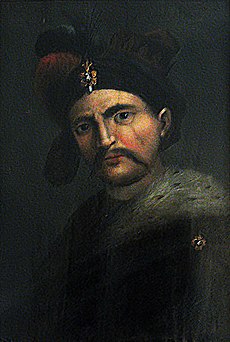Abbas the Great
| Abbas the Great | |
|---|---|
| Zell'ollah (Shadow of God) Ṣāḥebqerān-e-ʿAlāʾ (Supreme Lord of the Auspicious Conjunction) | |
 Portrait by an unknown Italian painter | |
| Shahanshah of Iran | |
| Reign | 1 October 1588 – 19 January 1629 |
| Predecessor | Mohammad Khodabanda |
| Successor | Safi Mirza |
| Born | 27 January 1571 Herat, Safavid Iran (modern-day Afghanistan) |
| Died | 19 January 1629 (aged 57) Mazandaran, Safavid Iran |
| Father | Mohammad Khodabanda |
| Mother | Khairun Nissa |
| Religion | Shia Islam |
Abbas the Great or Abbas I of Persia (Persian: شاه عباس بزرگ; 27 January 1571 – 19 January 1629) was a Persian ruler,[1] the 5th Safavid Shahanshah of Iran, and is generally considered one of the greatest rulers of Iranian history and the Safavid dynasty. He was the third son of Shah Mohammad Khodabanda.[2]
Muhammad Kodabanda had weak eyes and was not determined in the administration of the country and the monarchy. He was not a suitable politician to run Persia. Abbas the Great, with the help of Qizilbash tribal leaders, managed to gradually took power from his father during numerous wars, such as the Khorasan Wars, and finally sat on the throne in 1588.[3]
Early life
[change | change source]Abbas was a member of the Safavid dynasty of Kurdısh origin,[4][5][6][7][8][9][10][11][12][13] the Safavid family were descendants of the Persian[14][15][16][17][18][19] dervish (mystic) Safi ad-Din Ardabili. His mother, Khairun Nissa was of Mazanderani[20] origin.
References
[change | change source]- ↑ Polk, William R. (2018). Crusade and Jihad: The Thousand-Year War Between the Muslim World and the Global North. Yale University Press. p. 48, "(...) Safavid Iranian ruler Shah Abbas made his capital in 1598. (...)"
- ↑ Thorne, John O., ed. (1984). "Abbas I". Chambers Biographical Dictionary. Edinburgh, UK: Chambers Harrap.
- ↑ Roger Savory Iran Under the Safavids 1st Edition ISBN 978-0521042512
- ↑ Matthee, Rudi. (2005), The Pursuit of Pleasure: Drugs and Stimulants in Iranian History, 1500-1900, Princeton University Press, p. 18, "The Safavids, as Iranians of Kurdish ancestry and of nontribal background (...)"
- ↑ Savory, Roger. (2008). "EBN BAZZĀZ". Encyclopaedia Iranica, Vol. VIII, Fasc. 1. p. 8, "This official version contains textual changes designed to obscure the Kurdish origins of the Safavid family and to vindicate their claim to descent from the Imams. (...)"
- ↑ Amoretti, Biancamaria Scarcia; Matthee, Rudi. (2009), "Ṣafavid Dynasty", In Esposito, John L. (ed.) The Oxford Encyclopedia of the Islamic World, Oxford University Press; "Of Kurdish ancestry, the Ṣafavids started as a Sunnī mystical order (...)"
- ↑ Tapper, Richard. (1997), Frontier nomads of Iran: a political and social history of the Shahsevan, Cambridge University Press, p. 39, "The Safavid Shahs who ruled Iran between 1501 and 1722 descended from Sheikh Safi ad-Din of Ardabil (1252-1334). Sheikh Safi and his immediate successors were renowned as holy ascetics Sufis. Their own origins were obscure: probably of Kurdish or Iranian extraction (...)"
- ↑ Matthee, Rudi. (2008), "SAFAVID DYNASTY", Encyclopaedia Iranica; "As Persians of Kurdish ancestry and of a non-tribal background, the Safavids did not fit this pattern, though the state they set up with the assistance of Turkmen tribal forces of eastern Anatolia closely resembled this division in its makeup."
- ↑ Amanat, Abbas (2017). Iran: A Modern History. Yale University Press. p. 40, "The Safavi house originally was among the landowning nobility of Kurdish origin (...)"
- ↑ Bowering, Gerhard (2015). Islamic Political Thought: An Introduction. Princeton University Press. ISBN 978-1-4008-6642-7. p. 13, "The Safavids, of Kurdish origin and Turkic-speaking, arose from the Sunni Sufi fraternity of the Safawis organized in Azerbaijan by Safı al-Din (d. 1334)...".
- ↑ E. J. van Donzel (1994). Islamic desk reference. BRILL. ISBN 90-04-09738-4. p. 222, "Several dynasties, such as the Marwanids of Diyarbakir, the Ayyubids, the Shaddadis and possibly the Safawids, as well as prominent personalities, were of Kurdish origin."
- ↑ Bowering, Gerhard; Crone, Patricia; Kadi, Wadad; Mirza, Mahan; Stewart, Devin J.; Zaman, Muhammad Qasim (2013). The Princeton Encyclopedia of Islamic Political Thought. Princeton University Press. ISBN 978-0-691-13484-0. p. xii, "The Turkic-speaking Safavids of Kurdish origin arose from a Sunni Sufi fraternity that was organized in Azerbaijan by Safı al-Din (d. 1334)...".
- ↑ Manz, Beatrice Forbes (2021). Nomads in the Middle East. Cambridge University Press. p. 169, "The Safavid dynasty was of Iranian – probably Kurdish – extraction and had its beginnings as a Sufi order located at Ardabil near the eastern border of Azerbaijan, in a region favorable for both agriculture and pastoralism."
- ↑ Maisel, Sebastian (2018). The Kurds: An Encyclopedia of Life, Culture, and Society. ABC-CLIO. p. 7, "(...) Safavids, a Sufi religious order founded by a Kurdish mystic, Safi ad-Din Ardabili (1252–1334)."
- ↑ Kamal, Muhammad (2006). Mulla Sadra's Transcendent Philosophy. Ashgate Publishing, Ltd. p. 24, "(...) Shaykh Safi al-Din, a Sunni Sufi master descended from a Kurdish family (...)"
- ↑ Gelvin, James L. (2008), The Modern Middle East: A History, Oxford University Press, p. 331, "Shah Isma'il (reigned 1501-1520) Descendent of the Kurdish mystic Safi ad-Din (...)"
- ↑ Tapper, Richard. (1997), Frontier nomads of Iran: a political and social history of the Shahsevan, Cambridge University Press, p. 39, "The Safavid Shahs who ruled Iran between 1501 and 1722 descended from Sheikh Safi ad-Din of Ardabil (1252-1334). [...] Their own origins were obscure: probably of Kurdish or Iranian extraction (...)"
- ↑ Lapidus, Ira M. (2012). Islamic Societies to the Nineteenth Century: A Global History. Cambridge University Press. p. 492, "Shaykh Safi al—Din [...] a Sunni/Sufi religious teacher descended from a Kurdish family (...)"
- ↑ V. Minorsky, "The Poetry of Shāh Ismā‘īl I," Bulletin of the School of Oriental and African Studies, University of London 10/4 (1942): 1006–53.
- ↑ Newman, Andrew J. (2012). Safavid Iran: Rebirth of a Persian Empire. Bloomsbury Publishing.
